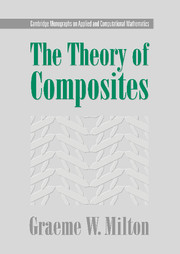Book contents
- Frontmatter
- Contents
- List of figures
- Preface
- 1 Introduction
- 2 Some equations of interest and numerical approaches to solving them
- 3 Duality transformations in two-dimensional media
- 4 Translations and equivalent media
- 5 Some microstructure-independent exact relations
- 6 Exact relations for coupled equations
- 7 Assemblages of spheres, ellipsoids, and other neutral inclusions
- 8 Tricks for generating other exactly solvable microgeometries
- 9 Laminate materials
- 10 Approximations and asymptotic formulas
- 11 Wave propagation in the quasistatic limit
- 12 Reformulating the problem of finding effective tensors
- 13 Variational principles and inequalities
- 14 Series expansions for the fields and effective tensors
- 15 Correlation functions and how they enter series expansions†
- 16 Other perturbation solutions
- 17 The general theory of exact relations and links between effective tensors
- 18 Analytic properties
- 19 Y-tensors
- 20 Y-tensors and effective tensors in electrical circuits†
- 21 Bounds on the properties of composites
- 22 Classical variational principle bounds
- 23 Bounds from the Hashin-Shtrikman variational inequalities
- 24 Bounds using the compensated compactness or translation method
- 25 Choosing the translations and finding microgeometries that attain the bounds†
- 26 Bounds incorporating three-point correlation functions†
- 27 Bounds using the analytic method
- 28 Fractional linear transformations as a tool for generating bounds†
- 29 The field equation recursion method†
- 30 Properties of the G-closure and extremal families of composites
- 31 The bounding of effective moduli as a quasiconvexification problem
- Author index
- Subject index
18 - Analytic properties
- Frontmatter
- Contents
- List of figures
- Preface
- 1 Introduction
- 2 Some equations of interest and numerical approaches to solving them
- 3 Duality transformations in two-dimensional media
- 4 Translations and equivalent media
- 5 Some microstructure-independent exact relations
- 6 Exact relations for coupled equations
- 7 Assemblages of spheres, ellipsoids, and other neutral inclusions
- 8 Tricks for generating other exactly solvable microgeometries
- 9 Laminate materials
- 10 Approximations and asymptotic formulas
- 11 Wave propagation in the quasistatic limit
- 12 Reformulating the problem of finding effective tensors
- 13 Variational principles and inequalities
- 14 Series expansions for the fields and effective tensors
- 15 Correlation functions and how they enter series expansions†
- 16 Other perturbation solutions
- 17 The general theory of exact relations and links between effective tensors
- 18 Analytic properties
- 19 Y-tensors
- 20 Y-tensors and effective tensors in electrical circuits†
- 21 Bounds on the properties of composites
- 22 Classical variational principle bounds
- 23 Bounds from the Hashin-Shtrikman variational inequalities
- 24 Bounds using the compensated compactness or translation method
- 25 Choosing the translations and finding microgeometries that attain the bounds†
- 26 Bounds incorporating three-point correlation functions†
- 27 Bounds using the analytic method
- 28 Fractional linear transformations as a tool for generating bounds†
- 29 The field equation recursion method†
- 30 Properties of the G-closure and extremal families of composites
- 31 The bounding of effective moduli as a quasiconvexification problem
- Author index
- Subject index
Summary
Analyticity of the effective dielectric constant of two-phase media
Consider an isotropic composite of two isotropic phases. When the microgeometry is fixed it has a complex effective dielectric constant ε⋆(ε1, ε2), which is a function of the complex dielectric constants ε1 and ε2 of the phases that depend on the frequency ω of the applied field. As a prelude to the proof given in the next section, we will now present a strong argument that shows why ε⋆(ε1, ε2) should have some rather special analytic properties. The argument is based on the premise that analyticity properties of the dielectric constant as a function of the frequency ω should extend to composite materials.
The properties of the function ε1(ω) [or ε2(ω)] are well-known and are discussed, for example, by Jackson (1975); see also section 11.1 on page 222. The function ε1(ω) is analytic in the upper half ω-plane, Im(ω) > 0. When Re(ω) = 0 the function takes real values of ε1(ω) ≥ 1, which decrease and approach 1 as │ω│ → ∞. Positive imaginary values of ε1(ω) occur when ω has a positive real part and negative imaginary values of ε1(ω) when ω has a negative real part. As ω ranges over the upper half-plane ε1(ω) can in principle range anywhere in the cut complex plane, where the cut extends along the real axis from −∞ to 1.
- Type
- Chapter
- Information
- The Theory of Composites , pp. 369 - 396Publisher: Cambridge University PressPrint publication year: 2002



